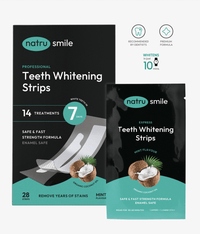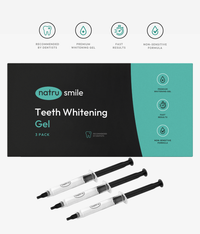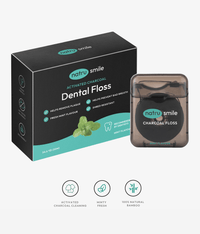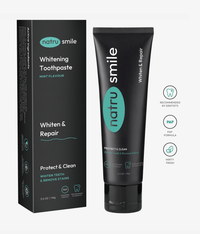
All products are certified by dental expert Dr. Greg Grillo
Have you ever thought about whether teeth shaving is the right choice for you or someone you know? Teeth shaving, commonly referred to as teeth filing or contouring, can serve various purposes in both cosmetic and restorative dental procedures.
In this extensive article, we'll thoroughly cover the benefits, purposes, potential side effects, and other considerations related to tooth shaving to help you determine if it might be suitable for your specific situation.
Understanding Tooth Shaving: What It Is And Why It's Done
Teeth shaving, or tooth reshaping, is a dental procedure that involves the removal of a small amount of enamel from a tooth's surface in order to modify its shape, size, or alignment. There are two primary types of tooth shaving: occlusal equilibration and cosmetic contouring. Here's a brief overview of each type:
Occlusal Equilibration
Occlusal equilibration is a technique that focuses on optimizing the way your teeth fit together when you bite down. By carefully removing small amounts of enamel from specific teeth, dentists can improve a tooth's contact with neighboring teeth, resulting in a more harmonious and balanced bite. This technique can be particularly beneficial for individuals who suffer from alignment issues, such as an overbite.
Cosmetic Recontouring
Cosmetic recontouring, on the other hand, primarily aims to improve the appearance of the teeth for aesthetic reasons. Within this category, a dentist might shave down a tooth that appears too long or misshapen, or they may reshape a canine tooth to make it more visually appealing. Generally, cosmetic recontouring involves either rounding or squaring off the edges of the front teeth to boost the smile's overall appearance and create a greater aesthetic balance.
Now that we've covered the basics, let's dive into the benefits, side effects, and candidates for tooth shaving.
Purpose Of Teeth Reshaping
Teeth reshaping, also known as teeth shaving or dental contouring, is a procedure that can serve various purposes and address different dental issues. In this section, we'll examine the various reasons a dentist might recommend teeth shaving, discussing each purpose in detail to help you better understand the rationale behind this procedure.
Reshaping Damaged Teeth
One primary reason for teeth reshaping is to repair a damaged tooth. If you have a chipped, cracked, or worn tooth, shaving off a small amount of enamel might help restore its natural appearance and protect it from further damage. In doing so, the dentist ensures that your teeth maintain a healthy and visually appealing structure.
Creating More Room In The Mouth
Another reason dentists might use teeth shaving is to make space for orthodontic treatment or more effective dental appliances. For instance, if your mouth is excessively crowded, your dentist might suggest teeth reshaping to make room for aligners, retainers, or other dental devices designed to improve your bite and overall oral health.
When Adding A Crown
Sometimes, a dentist will need to reshape a tooth before adding a crown to ensure a proper fit and appearance. Shaving down the tooth's surface allows the dentist to create an ideal foundation for the crown to sit on, ensuring a secure and natural-looking result.
Veneer Teeth Shaving
When preparing a tooth for a veneer, dentists might shave down the tooth's surface. Similar to crown preparation, this procedure helps ensure that the veneer will fit properly, look natural, and maintain a secure bond with the tooth. Without removing some tooth enamel, the veneer may appear bulky or unnatural.
Teeth Shaving For Braces
Orthodontists might use tooth shaving to create extra space in a crowded mouth or to speed up the teeth straightening process during orthodontic treatment. By removing a small amount of enamel from the sides of teeth, orthodontists can allow braces or other orthodontic devices to efficiently move and align the teeth into their correct positions, ultimately enhancing the overall effect of the treatment.
Adjusting Your Bite
Teeth reshaping can also be a relatively simple solution if you have an uneven bite. If your teeth don't align properly, you might experience discomfort, uneven wear on your teeth, or other dental complications. By shaving down specific teeth to create a more even bite, your dentist can improve your comfort level and reduce the risk of potential dental problems.
Benefits Of Teeth Filing
Teeth filing, also known as dental contouring or enameloplasty, is a cosmetic dental procedure that involves shaving and reshaping the surface of the teeth. This process aims to correct minor imperfections and enhance the overall appearance of the smile. There are several advantages to teeth filing, which we will explore in detail below.
Improved Appearance
One of the main benefits of teeth filing is the significant positive impact it can have on your appearance. The procedure can correct minor imperfections, such as chips, rough edges, or uneven teeth surfaces. By smoothing and reshaping the enamel, teeth filing creates a more uniform and appealing smile, boosting your self-confidence and overall satisfaction with your dental aesthetics.
Enhanced Comfort While Biting
Another advantage of teeth filing is the increased comfort you may experience while biting and chewing food. When the surfaces of your teeth are uneven or have rough edges, it can lead to discomfort and irritation during the normal function of your mouth. By contouring your teeth and creating a more even bite, teeth filing can help alleviate discomfort and make daily tasks, such as eating and speaking, more enjoyable.
More Effective Dental Appliance Fit
Teeth filing can also lead to a better fit for various dental appliances, such as mouthguards, retainers, or dentures. If your teeth are misshapen or crowded, it can be challenging to achieve a proper fit for these appliances, which could compromise their effectiveness or cause discomfort. By reshaping the teeth to create a more even and consistent dental arch, teeth filing can help ensure these appliances fit more securely and comfortably.
Faster Orthodontic Results
Finally, teeth filing can sometimes help enhance the efficiency of orthodontic treatments. By making minor adjustments to the shape and size of the teeth, the dentist or orthodontist can create more space within the mouth for the remaining teeth to move into their correct positions. This improved alignment can potentially result in faster orthodontic treatment times and more visually appealing results.
In conclusion, teeth filing is a valuable dental procedure that offers numerous advantages, including improved appearance, enhanced comfort while biting, better dental appliance fit, and potentially faster orthodontic results.
Teeth Shaving Cost: Factors To Consider And Price Range
The cost of tooth shaving can vary greatly depending on several factors, including the complexity of the procedure and the expertise of the dental professional who performs it. Tooth shaving is a cosmetic dental procedure that helps improve the appearance of teeth by removing small amounts of enamel to reshape and smooth the tooth's surface, making them more uniform and aesthetically pleasing.
In general, tooth reshaping costs can range from $50 to $300 per tooth. However, it's essential to consider multiple factors while determining the exact cost of tooth shaving for your specific case:
-
Dentist's Expertise: The experience and skill level of your dentist can directly impact the cost of tooth shaving. A dentist with an established reputation and extensive experience in cosmetic dentistry typically charges more for their services.
-
Geographical Location: The cost of dental procedures varies depending on the location. In urban areas with a high cost of living, dental treatment prices are usually higher than in rural areas.
-
Procedure Complexity: The more complex and time-consuming the tooth-shaving procedure is, the higher the cost will be. For example, if multiple teeth require reshaping, the price per tooth may increase.
- Additional Treatments: If the tooth shaving treatment is combined with other cosmetic dental procedures, the overall cost will increase. Additional treatments may include dental bonding, veneers, or orthodontic work.
- Dental Insurance Coverage: Depending on your dental insurance plan, your provider might cover part of the tooth shaving cost if it is deemed necessary for dental health reasons rather than purely cosmetic ones.
It's essential to consult with your regular dentist or a qualified cosmetic dentist to get a more accurate and personalized quote for tooth shaving. They will assess your dental condition and discuss the best cosmetic procedures to achieve the desired outcome within your budget.
Risks Of Teeth Contouring
Teeth contouring, also known as tooth reshaping or dental shaving, is a procedure used to make minor adjustments to the shape, length, or surface of teeth to improve their overall appearance. Despite being relatively safe, it's important to be aware of some potential risks and side effects associated with this dental procedure. Let's delve into these risks in more detail:
Removing Too Much Enamel
One of the primary concerns when performing teeth contouring is the possibility of removing too much enamel from the tooth. Enamel is the outer protective layer of the tooth, and when removed in excess, it can pose a significant risk to the tooth's overall strength and structure. This, in turn, can make the tooth more prone to fractures, chips, or breaks under pressure.
Tooth Sensitivity
The removal of enamel during teeth contouring can also result in tooth sensitivity. This occurs when the underlying dentin layer, which is more sensitive to temperature changes and pressure, becomes exposed. When this happens, patients may experience discomfort or sharp pain when consuming hot or cold beverages, sweet or acidic foods, or while brushing their teeth.
Chipping Or Cracking Of The Reshaped Tooth
Due to the changes in the structure of the tooth as a result of contouring, the reshaped tooth becomes more vulnerable to chipping or cracking. This risk amplifies if too much enamel has been removed, or if the patient has a predisposition for brittle or weakened teeth. In such cases, the patient may require additional dental work to repair or protect the affected tooth.
In conclusion, while teeth contouring can provide desirable aesthetic results, it's essential to be aware of the potential risks involved. Discussing these risks with your dentist and ensuring that they take necessary precautions can help mitigate the chances of complications arising from the procedure.
Does Tooth Shaving Hurt? A Closer Look Into The Procedure And Its Effects
Tooth shaving, also known as enameloplasty or tooth contouring, is a dental procedure that involves the removal of small amounts of the tooth's outer layer (enamel) to correct minor imperfections or shape the tooth. The primary concern for most patients when it comes to tooth shaving is whether or not the procedure is painful.
The Procedure Itself: What To Expect
Although the thought of having a tooth shaved may initially sound intimidating, it's important to note that teeth shaving procedures are typically painless because only the enamel is removed, and the tooth's more sensitive inner layers, such as the dentin and pulp, are left untouched. The process uses dental tools like fine sandpaper discs, polishing strips, and high-speed diamond burs to gently remove the excess enamel and reshape the teeth.
During the procedure, your dentist will apply a local anesthetic to numb the area around the tooth to ensure your comfort throughout the treatment. This means that you should not feel any pain during the actual tooth shaving.
Post-Procedure Sensitivity: What You Might Experience
While the tooth shaving procedure itself is not painful, you may experience some sensitivity in the treated area after the procedure. This sensitivity is typically the result of exposure of newer, thinner enamel, which can be temporarily more susceptible to temperature changes and touch.
The post-procedure sensitivity usually subsides within several days or weeks, and proper dental care – including using a toothpaste formulated for sensitive teeth and brushing with a soft-bristled toothbrush – can help alleviate any discomfort experienced during the healing period.
In summary, tooth shaving is generally a painless procedure, but some patients may experience temporary sensitivity after the treatment. If you have concerns or questions about tooth shaving, be sure to consult with your dentist, who can provide more personalized information and guidance tailored to your specific situation.
Are You A Candidate For Teeth Shaving? Understanding Tooth Reshaping
If you've been bothered by a minor tooth imperfection, such as a small chip, slightly uneven tooth length, or a minor overbite, you might find yourself wondering if tooth shaving is a viable option for you.
As an ideal candidate for tooth shaving, you would have minor dental defects that can be corrected through this procedure. Before making any decisions, however, it is crucial to consult your dentist to determine if teeth shaving is the right option for you and your dental needs.
Can You Shave Your Own Teeth At Home? Risks And Recommendations
Although it might be tempting to attempt shaving your teeth at home to save time and money, doing so presents significant risks. Shaving your teeth without professional guidance and specialized tools may lead to permanent damage to your teeth or even put you at risk for accidental injuries. It is always best to rely on the expertise of a dental professional for any tooth reshaping procedures to ensure that the process is both safe and effective.
Can You Get Veneers Without Shaving Teeth? Exploring Minimal-Prep And No-Prep Options
For those who are hesitant about tooth shaving but still want to improve their smile with veneers, there is some good news! In certain instances, you can get veneers without the need for tooth shaving. Minimal-prep or no-prep veneers are designed to fit on the tooth with little to no tooth reduction. However, they might not be suitable for everyone. To determine if no-prep veneers are an appropriate option for your specific situation, it's essential to discuss your dental needs and preferences with your dentist.
Does Shaving Teeth Cause Sensitivity? Understanding Potential Side Effects
When considering teeth shaving, many people wonder if the process will lead to increased sensitivity. The truth is that shaving teeth can cause temporary sensitivity due to the removal of enamel. However, this sensitivity usually subsides within a few days to weeks following the procedure, allowing you to enjoy your newly shaped teeth without discomfort.
Is Teeth Shaving Necessary? Determining The Need For Tooth Reshaping
The necessity of teeth shaving is not universal and depends entirely on your specific dental needs and desired outcomes. For some patients, tooth reshaping may be the most effective way to address their dental concerns, while others may benefit more from alternative treatments. Consult with your dentist to determine if tooth reshaping is the right choice for you based on your dental goals and any underlying dental issues.
Is Teeth Shaving Safe? Weighing The Risks And Benefits
When carried out by a skilled and trained dental professional, teeth shaving is considered a safe and minimally invasive procedure. However, it is worth noting that there are some risks involved, such as temporary sensitivity or the potential for permanent tooth damage if done incorrectly. To minimize these risks, always trust a certified dental professional to perform teeth shaving or any dental procedures.
How Long Does Teeth Shaving Take? Time Frames For Tooth Reshaping
The duration of tooth shaving procedures is determined by factors such as which teeth require reshaping and the extent of work needed. Simple tooth reshaping cases can typically be completed in a single visit, while more complex situations may necessitate multiple appointments to achieve satisfactory results.
How Can I Fix My Teeth Without Shaving? Alternative Treatment Options
If you're searching for ways to fix your teeth without shaving, there are several alternative solutions available, including dental bonding, orthodontic treatments, or using dental appliances such as retainers or aligners. It's essential to discuss these options and their suitability for your dental concerns with your dentist to identify the best solution tailored to your needs.
Can I Shave My Front Teeth? Choosing The Right Solution For Your Dental Needs
While it is possible to shave down your front teeth if necessary, it's essential to first consult with a dental professional to ensure that tooth reshaping is the appropriate solution for your specific needs. Like with any dental procedure, your dentist will assess your situation and recommend the most effective and safe course of action.
In conclusion, teeth shaving can offer numerous benefits and address a multitude of dental issues. Nevertheless, it's vital to maintain open communication with your dentist to determine if tooth reshaping is the right choice for your unique dental situation. By understanding the procedure and working closely with your dentist, you can achieve a more attractive and confident smile.










